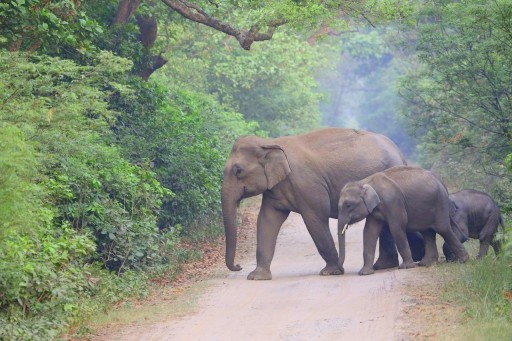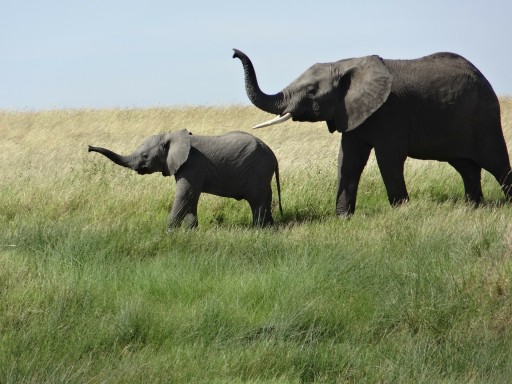15 amazing facts you probably didn’t know about Elephants
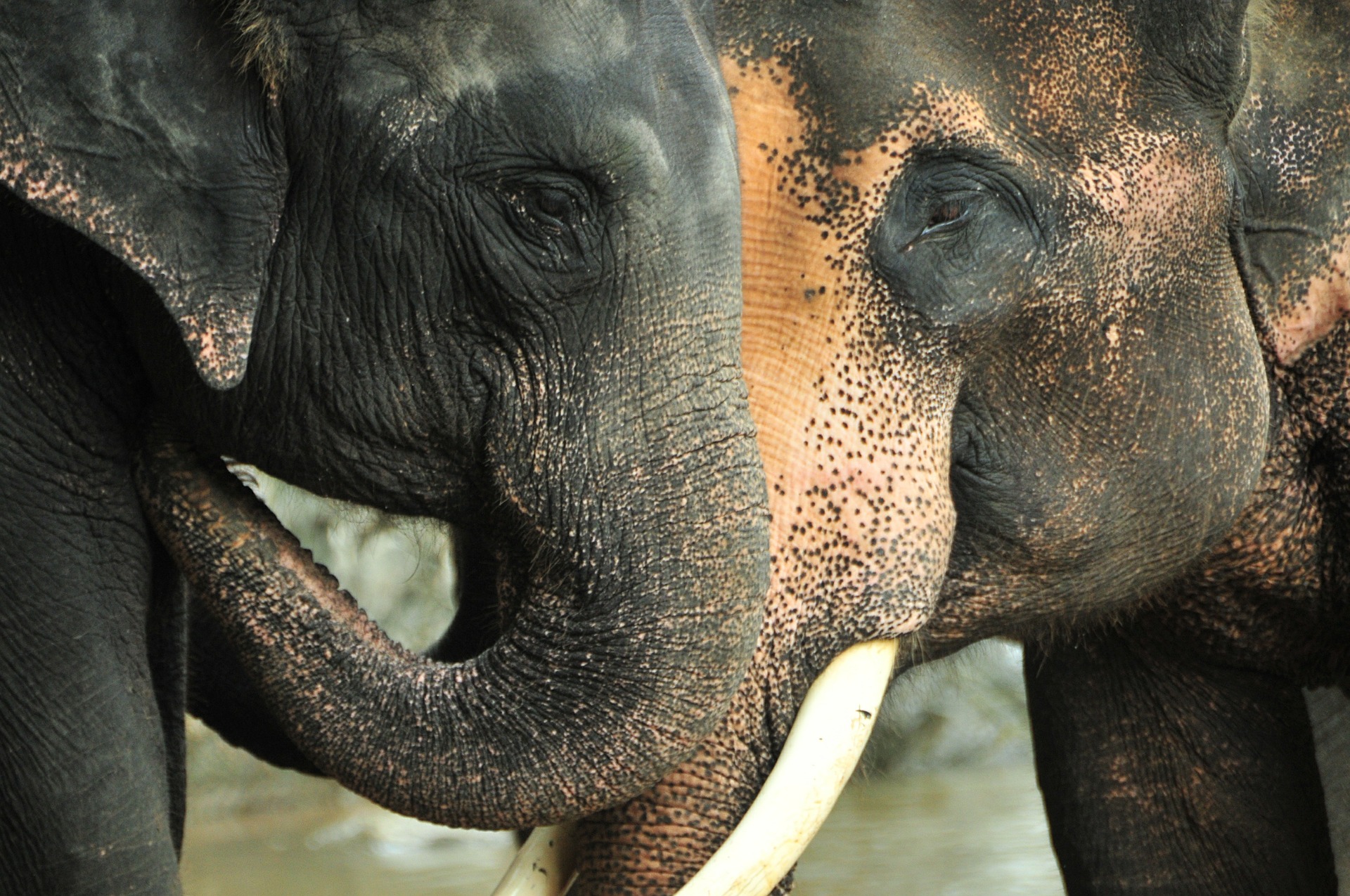
If you were to ask me which species I love the most, even though it would be extremely hard for me to pick just one, I would have to say elephants (Elephas maximus)! My first encounter with an elephant was when I was around 14yrs old. I had the privilege of making friends with a temple elephant called “Shashi,” which means moon. I still vividly remember that summer day I accompanied my parents to a temple in North Paravoor, roughly 5 hours by car from where I lived at the time in Kerala, India. I was introduced to Shashi by the temple manager. He was 43 years old at the time and under quarantine for injuring his abusive caregiver. Quarantine here means he was confined to a half-acre of land and was not permitted to participate in any temple festivities.
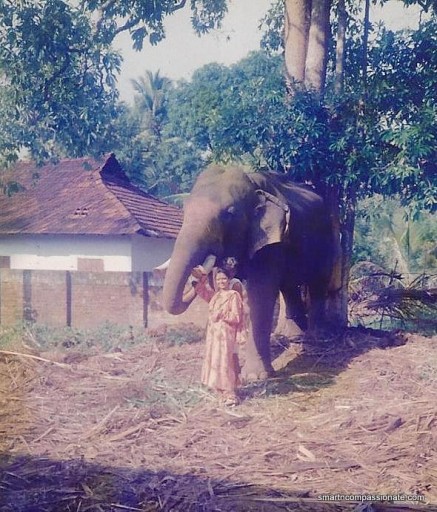
I spent the entire day feeding him bananas and coconuts and playing hide and seek, he would sniff me out and gently twist his trunk around my arm, and I even got to bathe him. Needless to say, it was one of the most memorable days of my life! I couldn’t even imagine him hurting a fly, let alone a caregiver. One of his idiosyncrasies was that he would not respond to people who disrespectfully called his name. Semantics and syntax were very important to him. “Eda,” an informal way of calling a male in Malayalam, a language spoken in Kerala, will only get you the cold shoulder. Some of the acceptable ways of addressing him were ‘Sir,’ ‘Chetta’ (brother), ‘Mone’ (son), ‘Kutta’ (little one), and basically any term of endearment. He was the gentlest giant I have ever met.
Another one of my most memorable experiences was during a college trip from Kerala to Karnataka. My college mates, profs, and I were lucky enough to meet a wild elephant calf on a highway that ran through Bandipur National Park and walk away in one piece. The calf was standing by the road with her Mom, and we did what most people would do in such a situation. We stopped the bus to observe and admire! Something about seeing a bus full of college students really got this little calf excited, and she walked right over as happy as could be. And, of course, some of us had to disembark and reciprocate her greetings; otherwise, it would’ve been just plain rude. She let us touch her without any reservations, and more importantly, Mom did not object. She just stood there about 15ft away, perfectly still, intently watching her precious bundle of joy. Today as a Mother, when I look back, I can’t help but admire her composure, devotion, and ability to judge the situation, considering that humans have been the most ruthless towards her kind.
Here are 15 fascinating facts about elephants.
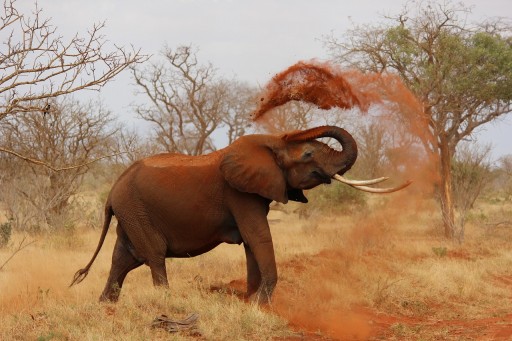
1. Elephants are the largest land animals in the world.
The largest elephant on record is a male African elephant who weighed about 24,000 lbs and was 13ft tall at the shoulder. The average elephants heart weighs about 27-46 lbs, and the average brain has a mass of over 11 lbs. Asian elephants are shorter, heavier, and have smaller ears than their African cousins.
2. Elephants have the longest gestation period of all animals.
Elephants reach reproductive maturity around age 16 and their gestation period is 22-24 months, almost 2yrs. Even though their life span is well over 70 years, they typically do not give birth to more than four off-springs in their lifetime. A newborn elephant weighs about 260lb.
3. Elephant calves suck their trunk for comfort, much like human babies suck their thumbs.
Their trunk is the fusion of their upper lip and nose and has more than 100,000 muscles. They have a fantastic sense of smell even though their eyesight is relatively poor, and they wave their trunks up in the air and from side to side to get a better whiff of their surroundings. The elephant’s trunk can sense an object’s size, shape, and temperature. It’s also used to lift food and suck up water which is then poured into their mouth and used like a snorkel to breathe in deep water.
4. Elephants prefer one tusk over the other.
Elephants use their tusk to defend, dig for water and lift objects, among other things, and they usually prefer one over the other, just as people are either left or right-handed. The elephants’ ability to locate underground water and dig pools helps provide many other species with water during droughts. These elongated incisors are the main reason elephants have been so heavily hunted.
5. Elephants use infrasound and seismic communication over long distances.
Elephants are very vocal, yet humans just realized this recently because much of their talk is below the threshold of our hearing, called Infrasound (Payne, Langbauer, Jr., & Thomas, 1986). They generally make a variety of vocalizations, including rumbles, screams, and trumpets. Rumbles are low-frequency calls that often fall partially or entirely in the infrasonic range, between 5Hz and 30Hz. The lower the frequency of a sound, the longer its sound wave; therefore, it can travel farther without being absorbed or reflected by the environment. So far, studies show that elephants can hear them over 4 miles away from where the sound originated. (Larom, Garstang, Payne, Raspet, & Lindeque, 1997). These low-frequency calls also generate powerful vibrations in the ground that the elephants can feel (via their sensitive trunks and feet), interpret, and respond to them appropriately. Perhaps this could explain why during the 2004 Tsunami, elephants in Thailand ran for higher ground before the devastating waves crashed (Langbauer, Jr., Payne, Charif, Rappaport, & Osborn, 1991).
Researchers at Cornell University are compiling an elephant dictionary.
6. Elephants recognize themselves in mirrors
Even though recognizing oneself in the mirror is an ability humans take for granted, it is actually a cognitive capacity that few animal species possess. The only species to have passed this mirror self-recognition test are the Great Apes, dolphins, Eurasian magpies, and elephants. (Plotnik, de Waal, & Reiss, 2006). This demonstrates that an animal is able to see itself as separate from others (self-aware), one of the main traits underlying empathy and complex sociability.
https://www.youtube.com/watch?v=g5LfYHJWUtE
7. Elephants are altruistic
Altruism is defined as a selfless concern for the welfare of others. In the case of elephants, this selfless concern is not just extended to members of their own species but to other species in distress, including humans. There have been many documented incidences of elephants assisting other species at the risk of their own safety. One is that of an elephant who relentlessly tried to save a baby rhinoceros stuck in the mud even though the baby’s mother was attacking her. A working elephant in India refused to lower a log into a hole because a dog was sleeping in it and only lowered it after the dog was moved to a safe distance (Pillai, 1941). There have been many recorded instances where elephants have protected and comforted (by gently touching with their trunk) humans in distress ( (Poole J., 1996).
8. Elephants manufacture and use tools with their trunk and feet.
Asian elephants have the greatest volume of cerebral cortex available for cognitive processing of all existing land animals, including all primate species. Their brain exhibits a gyral pattern more complex, with more brain folds, than that of humans, primates, or carnivores (Shoshani, Kupsky, & Marchant, Elephant brain: Part I: Gross morphology, functions, comparative anatomy, and evolution, 2006) and has as many cortical neurons (nerve cells) and cortical synapses as that of humans! (Stamenov & Gallese, 2002). Both wild and captive elephants break off appropriate size branches and sticks to fan away flies (Hart, Hart, McCoy, & Sarat, 2001), remove ticks, to scratch themselves, and places twigs and branches under their feet to prevent sinking in soft ground (Shoshani & Eisenberg, Intelligence and survival, 2000). They clean tufts of grass with soil in them by smacking it against their foot until all the soil has been shaken off or by washing it if water is available. In one report,t elephants were observed chewing the bark of a tree to make a “cork” to plug a waterhole they dug. Later, these same elephants were observed to return to that waterhole, unplug the cor,k and have a drink (Gordon, 1966). Elephants have also been reported to plug, with mud, wooden bells they wear on their necks so that the clappers cannot ring while they enter a grove of cultivated bananas at night (Williams, 1950). They have been known to intentionally throw or drop large rocks and logs on the live wires of electric fences, either breaking the wire or loosening it such that it makes contact with the earth wire, thus cutting off the electricity.
This video shows an elephant in a zoo using a stick to get fruits.
9. They have one of the most closely-knit societies of any animal.
The most experienced female or Matriarch leads the herd, and all group members work together to find food and care for each other’s calves. Even when a herd member is sick and weak, the others will bring her food and support her to stand. In case of death, they will usually try to revive them with food and water before giving up. A female will only leave her herd if she dies or is captured by humans. In her book Small as an Elephant, Jennifer Richard Jacobson writes, “Elephants love reunions. They recognize one another after years and years of separation and greet each other with wild, boisterous joy. There’s bellowing and trumpeting ear flapping and rubbing. Trunks entwine.”
10. They are known to self-medicate.
Pregnant elephants walk miles away from their usual food source, searching for a specific plant that induces labor. Kenyan women also brew the same plant to make labor-inducing tea. (Eugene, 2002)
11. They are nature’s gardeners.
The tropical rainforests of Africa and Asia keep our planet healthy by moderating our climate, absorbing the carbon we produce, maintaining the water cycle, and are home to countless species of plants and wildlife. Almost 95% of tropical forest trees depend on animals to disperse their seeds, which the trees make enticing by wrapping them in a tasty little packet called fruit. Elephants are typically the largest consumers and distributors of these seeds. Not only do they consume a large number of fruits, but they also walk great distances and distribute these seeds wrapped in dung/fertilizer many miles away from the parent plant, thereby promoting biodiversity. Elephants are a keystone species that influence the composition of their environment while often benefiting other species.
https://www.youtube.com/watch?v=oCmHtxWT1Bk
12. Elephants are the only mammals other than Homo sapiens sapiens and Neanderthals that are known to have death rituals.
When one of the herd members perishes, the herd becomes very quiet and will dig a shallow hole and bury the deceased with dirt and branches. They will stay at the grave for days after the burial, and the elephants that were particularly close to the deceased will show signs of depression. The herd will show similar respect even when they run into unknown dead elephants. There are even reported cases of elephants burying dead humans they have come across on their way. Elephant researcher Martin Meredith recalls in his book Elephant Destiny: Biography of an Endangered Species in Africa a typical death ritual that was witnessed, “The entire family of a dead matriarch, including her young calf, were all gently touching her body with their trunks, trying to lift her. The elephant herd was all rumbling loudly. The calf was observed to be weeping and made sounds that sounded like a scream, but then the entire herd fell incredibly silent. They then began to throw leaves and dirt over the body and broke off tree branches to cover her. They spent the next two days quietly standing over her body. They sometimes had to leave to get water or food, but they would always return.”
13. Elephants suffer from the equivalent of post-traumatic stress syndrome (PTSD)
The hippocampus is a brain structure in the limbic system that plays important roles in the consolidation of information from short-term memory to long-term memory, spatial navigation, and is linked to emotion. This structure is much bigger in an elephant than that of any primate (including humans) or cetacean (“Mechanisms of Economic and Social Decision-Making.” Allman Labs. Retrieved 2007-11-03.). The hippocampus of an elephant takes up about 0.7% of the central structures of the brain, comparable to 0.5% for humans, 0.1% in Risso’s dolphins, and 0.05% in bottlenose dolphins (Hakeem et al., 2005). Captivity, poaching, culls, and the stress of life in shrinking habitats are some of the causes of Complex PTSD and other trauma-induced conditions in ,elephants (Bradshaw, Schore, Brown, Poole, & Moss, 2005).
More ABC US news | ABC World News
14. Despite our differences, humans and elephants are similar in many ways.
Even though the common ancestor of humans and elephants lived at least 600 million years ago, we have much in common, suggesting convergent evolution (Morris et al., 2009). We’re both long-lived animals with rich social lives and very large brains. An elephant’s brain looks similar to a human brain, highly folded and convoluted with distinctive lobes. And recent studies show that humans and elephants have developed similar adaptations to provide our growing cortex with much-needed energy. Like us, elephants also exhibit a wide variety of behaviors, including those associated with grief, learning, allomothering, mimicry, play, altruism, use of tools, compassion, cooperation (Morris et al., 2009), self-awareness, memory, and possibly language. In addition, most mammals are born with a brain close to 90% of the adult weight. In comparison, Humans are born with 28% and elephants 35%, indicating that, like us, elephant calves must also learn the ropes of life from family, friends, play, and social interactions. Another similarity is the presence of spindle neurons, which appear to play a central role in higher cognitive functions in both human and elephant brains (Hakeem et al., 2009). It’s also found in the brains of Great Apes and certain cetaceans. And like us, they are also great problem solvers being able to change their behavior radically to face new challenges. Here’s an example of their problem-solving skills.
A study at the University of Tokyo shows that elephants might actually be better at mental arithmetic than humans (Irie-Sugimoto, Kobayashi, Sato, & Hasegawa, 2009). In the study, the elephants got an average score of 74%, with one elephant scoring as high as 87%, while the humans managed a success rate of just 67%.
It’s also worth noting that their cerebrum temporal lobes, which function as storage of memory, are much larger than those of a human (Poole J., 1996), so perhaps there is some truth to the adage “An elephant never forgets.”
15. Their numbers are dwindling at an alarming rate.
The loss of natural habitat, poaching for ivory, and human-elephant conflict are serious threats to the sustainability of elephants in the wild. It was estimated that in 1930 there were about 7-10 million African elephants which declined to 1.3 million by 1979 and further declined to 472,000 – 690,000 in 2007. Although some experts believe the number may be as low as 250,000 now. The population of African forest elephants have declined by 62% between 2002-2011 and lost 30% of its geographical range (Maisels et al., 2013). Their population is now less than 10% of its potential size, occupying less than 25% of its potential range. Since 1986, Asian elephants have been listed as endangered by IUCN as the population has declined by at least 50% over the last three generations to a mere 35,000. Approximately 30% of the entire Asian Elephant population is currently in captivity. Even though the life expectancy of wild elephants is the same as our own, in captivity (zoos, circuses, tourism, etc.), they only live for an average of 17-19yrs, and the death rates for infant Asian elephants are especially high (Ros et al., 2008). Knowing everything we currently know about elephants, researchers argue that it’s morally wrong for humans to cull these magnificent beings (Tom, 2002)
“The elephant is the animal that surpasses all others in wit and mind.” Aristotle.
WHAT CAN WE DO TO HELP?
Here are 15 things we can do to save the elephants
References
Bradshaw, G. A., Schore, A. N., Brown, J. L., Poole, J. H., & Moss, C. J. (2005, February 24). Elephant bre,akdown. Nature, 433(7028), 807-807.
Eugene, L. (2002). The octopus and the orangutan: More tales of animal intrigue, intelligence and ingenuity. New York City: Plume.
Gordon, J. A. (1966). Elephants do think. African Wildlife, 20(1), 75-79.
Hakeem, A. Y., Hof, P. R., Sherwood, C. C., Switzer, R. C., Rasmussen, L. L., & Allman, J. M. (2005). The brain of the African elephant (Loxodonta africana): neuroanatomy from magnetic resonance images. The Anatomical Record Part A: Discoveries in Molecular, Cellular, and Evolutionary Biology, 287(1), 1117-1127.
Hakeem, A. Y., Sherwood, C. C., Bonar, C. J., Butti, C., Hof, P. R., & Allman, J. M. (2009). Von Economo neurons in the elephant brain. The Anatomical Record, 292(2), 242-248.
Hart, B. L., Hart, L. A., McCoy, M., & Sarath , C. R. (2001, November). Cognitive behaviour in Asian elephants: use and modification of branches for fly switching. Animal Behaviour, 62(5), 839-847.
Irie-Sugimoto, N., Kobayashi, T., Sato, T., & Hasegawa, T. (2009). Relative quantity judgment by Asian elephants (Elephas maximus). Animal Cognition, 12(1), 193-199.
Langbauer, Jr., W. R., Payne, K., Charif, R., Rappaport, E., & Osborn, F. (1991). African elephants respond to distant playbacks of low-frequency conspecific calls. Journal of Experimental Biology(157), 35-46.
Larom, D., Garstang, M., Payne, K., Raspet, R., & Lindeque, M. (1997). The influence of surface atmospheric conditions on the range and area reached by animal vocalizations. Journal of Experimental Biology(200), 421-431.
Maisels, F., Strindberg, S., Blake, S., Wittemyer, G., Hart, J., Williamson, E. A., & Aba’a, R. (2013). Devastating Decline of Forest Elephants in Central Africa. PLOS ONE.
Morris, G., Sterner, K. N., Islam, M., Uddin, M., Sherwood, C. C., Hof, P. R., & Hou, Z.-C. (2009). Phylogenomic analyses reveal convergent patterns of adaptive evolution in elephant and human ancestries. Proceedings of the National Academy of Sciences, 106(49), 20824-20829.
Payne, K., Langbauer, Jr., W. R., & Thomas, E. (1986). Infrasonic calls of the Asian elephant (Elephas maximus). Behavioral Ecology and Sociobiology(18), 297-301.
Pillai, N. G. (1941). On the height and age of an elephant. J. Bombay Nat. Hist. Soc, 42, 927-928.
Plotnik, J. M., de Waal, F. M., & Reiss, D. (2006). Self-recognition in an Asian elephant. Proceedings of the National Academy of Sciences, 103 (45), pp. 17053–17057.
Poole, J. (1996). Coming of Age with Elephants. Chicago, Illinois: . ISBN 034059179X: Trafalgar Square.
Poole, J. (1996). Coming of age with elephants: A memoir. New York: Hyperion.
Ros, C., Rowcliffe, M., Lee, P., Mar, K. U., Moss, C., & Mason, G. J. (2008). Compromised survivorship in zoo elephants. Science, 322(5908), 1649-1649.
Shoshani, J., Kupsky, W. J., & Marchant, G. H. (2006). Elephant brain: Part I: Gross morphology, functions, comparative anatomy, and evolution. Brain research bulletin, 70(2), 124-157.
Shoshani, J., & Eisenberg, J. F. (2000). Intelligence and survival. In J. Shoshani, Elephants: Majestic creatures of the wild (pp. 134-137). New York: Checkmark Books.
Stamenov, M., & Gallese, V. (2002). Mirror neurons and the evolution of brain and language (Vol. 42). John Benjamins Publishing.
Tom, P. (2002). The debate over elephant culling: Is it ever morally justified to cull elephants? Zambezia, 29(1), 76-81.
Williams, J. H. (1950). Elephant Bill. London: Rupert Hart-Davis.
